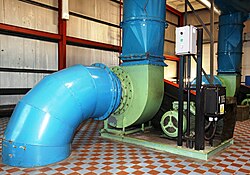Aeration turbine
This article needs additional citations for verification. (April 2019) |

Aeration turbines are designed to aerate and mix fluids industrially. They are foremost used in brewing, pond aeration and sewage treatment plants.[1]
Aeration turbines are designed for mixing gases, usually air, with a liquid, usually water. They can serve additional purposes like destratification, agitator or pump.
There are numerous design variations in use or newly entering the market. Most are centrifugal, where fluid enters at the axis and exits around the perimeter of the rotor. Aeration turbines can run open or in a housing. Some designs have bladed rotors which leads to more splashing and those need to run close to the surface, which is an obvious sign of lesser efficiency.
Generally the performance efficiency of aeration turbines is very high, the space requirement is compact, both at high reliability and all those factors reduce operational cost.
The use of aeration turbines in industry is still underdeveloped especially with waste water treatment. With raising population and the growing strain on clean water supplies such environmentally friendly solutions are becoming more important.
The technology allows a more decentralized approach to waste water treatment as sewage can be oxygenised at pumping stations for bacteria to start breaking down the sewage before it even arrives at centralized processing plants.[2]
Aeration turbines are more and more entering industry because of their significantly higher efficiency and reduced size of used gear compared to other methods of aeration. This means less investment into process infrastructure and substantial savings to both the overall cost but foremost running cost for electricity.[citation needed]
Reference List[edit]
- ^ Ramalho, R. S. (Rubens Sette) (1983). Introduction to wastewater treatment processes (2nd ed.). New York: Academic Press. ISBN 0125765606. OCLC 8495092.
- ^ Ward, Stuart (2011). "Regenerative turbine aeration technology: by applying the laws of physics while regularly utilizing properly sized bubbles, managers and technicians can achieve consistent wastewater treatment system results". Pollution Engineering. 43 (10): 19–23 – via JSTOR.
